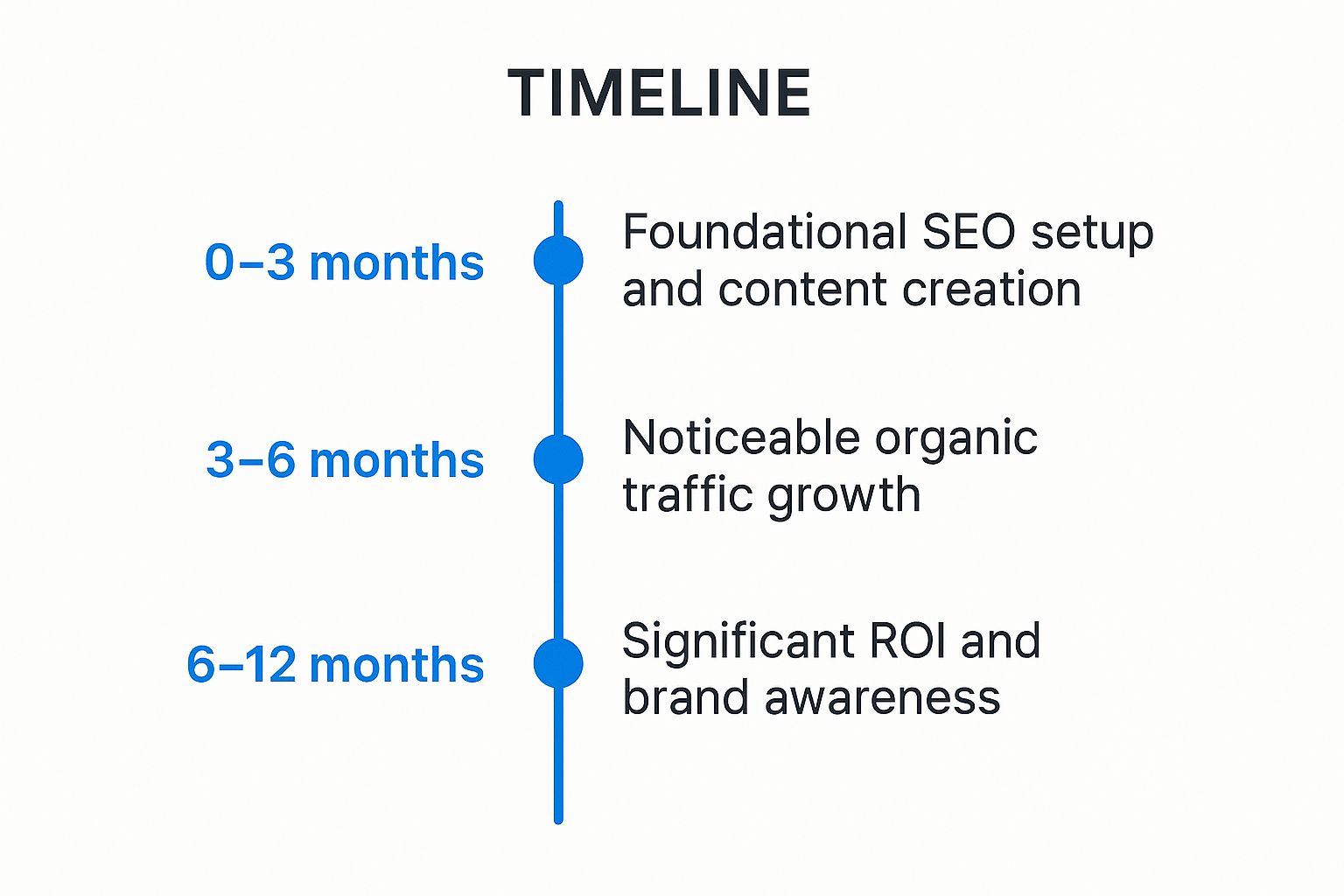

As a small business owner, every marketing dollar counts. While flashy ads and social media campaigns have their place, they often require a continuous, costly investment to deliver results. But what if there was a way to build a sustainable source of high-quality leads that works for you 24/7, compounding in value over time? This is the core power of Search Engine Optimization (SEO).
Many entrepreneurs mistakenly view SEO as a complex, technical mystery reserved for large corporations with massive budgets. In reality, understanding the benefits of SEO for small business reveals it’s one of the most cost-effective and impactful marketing channels available. It's the engine that drives consistent, organic traffic from customers actively searching for your services, whether you're a roofer, a lawn care provider, or a local ABA clinic.
This guide moves beyond theory to provide actionable insights. We will break down the eight most significant advantages of a strong SEO strategy, demonstrating how it helps you outrank larger competitors, attract ready-to-buy customers, and build a lasting, trustworthy brand. You will learn why SEO isn't just a 'nice-to-have' marketing tactic; it's an essential, foundational strategy for long-term survival and measurable growth.
One of the most significant benefits of SEO for small business owners is its incredible cost-effectiveness and potential for high return on investment (ROI). Unlike paid advertising, where traffic stops the moment you stop paying, SEO builds a sustainable, long-term asset. It targets users who are already actively searching for your exact products or services, making them highly qualified and ready to convert.
This approach allows small businesses to compete with larger corporations without needing a massive advertising budget. Organic search rankings are earned through relevance and quality, not by outbidding competitors, leveling the playing field and rewarding businesses that genuinely serve their audience.

The value of SEO becomes clear when you look at the results. For example, a local plumbing company investing $500 per month in local SEO might generate over $15,000 in monthly revenue directly from organic search leads. In another scenario, a regional accounting firm successfully generated 70% of its new clients through organic search after just 12 months of consistent SEO efforts. SEO fits into a broader plan; you can learn more about other digital marketing strategies to see how it compares.
To achieve a strong ROI, a strategic approach is essential. Don't try to compete for broad, highly competitive keywords right away.
For small businesses with a physical location, one of the most immediate benefits of SEO for small business success is its ability to drive local visibility and foot traffic. Local SEO focuses on optimizing your online presence to attract customers in your specific geographic area. Since 46% of all Google searches have local intent, this strategy directly connects you with highly motivated buyers searching for services "near me" or within a particular city.
This targeted approach ensures your business appears prominently in Google Maps and the "local pack" search results, often above the traditional organic listings. When potential customers are nearby and ready to make a purchase, local SEO puts your business front and center, making it the most convenient and obvious choice.

The impact of local optimization is tangible and direct. For instance, a coffee shop in Austin saw its foot traffic increase by 45% after thoroughly optimizing its Google Business Profile with high-quality photos, regular posts, and active review management. Similarly, a family-owned restaurant now attributes 60% of its new customers to appearing in the top 3 local pack results for relevant searches. A local dentist successfully used this strategy to rank #1 for "dentist in [city]," generating over 30 direct phone calls each week from Google Maps alone.
To dominate local search, a focused and consistent strategy is key. Start by making your business easy for Google and customers to find.
Another one of the core benefits of SEO for small business is its power to build lasting credibility and trust. When your business appears on the first page of Google, it sends a powerful signal to potential customers that you are a legitimate and authoritative player in your industry. Users inherently trust organic search results more than paid ads, which are often viewed with skepticism.
This trust is earned, not bought. Search engines like Google reward websites that provide excellent user experiences, secure browsing (HTTPS), and high-quality, helpful information. By optimizing for these factors, you are not just pleasing an algorithm; you are demonstrating to your audience that you are a reliable and trustworthy resource.
The impact of this earned credibility is tangible. For instance, a small local law firm that consistently publishes well-researched legal guides can outrank larger, more established competitors, positioning itself as a thought leader. Similarly, a boutique marketing agency can win high-value clients from bigger agencies simply because its comprehensive blog content establishes deep expertise and credibility long before the first sales call.
Building trust through SEO is a strategic process that goes beyond just keywords. Focus on creating a foundation of authority that resonates with both users and search engines.
A crucial benefit of SEO for small business owners is the significant competitive edge it provides, especially in local markets. Many competitors, particularly traditional businesses, still neglect their online presence. This creates a powerful opportunity for you to capture market share by simply being the one that shows up in search results when potential customers are looking for a solution.
By investing in a solid SEO strategy, you can systematically outrank larger, less agile competitors who rely on brand recognition or paid ads alone. When a customer searches for a service and your business appears at the top while your competitor is nowhere to be found, you have effectively intercepted that lead. This is how small businesses win battles against bigger players, one search at a time.
Gaining a competitive advantage through SEO is a proven strategy. For example, an independent bookstore can outrank national chain stores for "local author book signing" by creating targeted content and local event pages. Similarly, a small gym can dominate search results for "personal training in [City Name]" by optimizing its Google Business Profile and building local citations, pushing national fitness chains down the page. This approach helps you build a stronger online presence where it matters most.
To turn SEO into your competitive weapon, you must be strategic and observant. Don’t just build your own strategy; analyze what your competitors are doing (or not doing).
A key advantage that underscores the benefits of SEO for small business is the direct link between search optimization and creating a positive user experience (UX). Google's algorithms reward websites that are fast, intuitive, and helpful. When you optimize for technical SEO, you are simultaneously improving your site's usability for actual visitors, making it easier for them to find what they need and complete their goals.
This dual focus ensures that the traffic you attract is more likely to engage, stay longer, and convert. A technically sound and user-friendly website directly contributes to higher customer satisfaction and a stronger brand reputation, which search engines recognize and reward with better rankings.

Improving site performance translates into tangible business results. For instance, an e-commerce store that reduced its page load time from 5 to 2 seconds saw a 27% increase in conversions. In another case, a service business simplified its website's navigation, leading to a drop in its bounce rate from 65% to 42%. Similarly, a local restaurant that made its website mobile-responsive experienced a 55% jump in online reservations. These examples show how a better UX directly fuels business growth.
Focusing on technical health and usability is crucial for both users and search engines. Start with these foundational improvements.
One of the most powerful benefits of SEO for small business is the ability to track and measure nearly every aspect of your campaign. Unlike traditional advertising like print or billboards, where ROI is often a guess, SEO provides clear, actionable data. You can see exactly which strategies are working, how users find you, and what they do once they arrive on your site.
This data-driven approach removes guesswork from your marketing efforts. Small businesses can make informed decisions based on real performance metrics, allowing them to allocate their budget and time to the activities that deliver the best results. You gain a deep understanding of customer behavior, which can inform not just your marketing but your entire business strategy.
The value of SEO data becomes tangible when you see how it drives business growth. For example, a small consulting firm used Google Analytics to discover that 80% of its qualified leads came from just five specific blog posts. They then created more content on those topics, doubling their lead generation in six months. In another case, a local e-commerce store identified high-traffic product pages with low conversion rates, optimized the page layout and checkout process, and increased monthly revenue by over $12,000. These insights empower you to make smarter, more profitable decisions.
To turn raw numbers into actionable insights, you need a systematic approach to tracking and analysis.
A crucial benefit of SEO for small business owners is its role as an investment in long-term, sustainable growth, not just a short-term tactic. While paid advertising traffic vanishes the moment you stop paying, SEO creates a digital asset that compounds in value over time. Well-optimized content continues to attract organic visitors for months and even years, establishing your business as a trusted industry resource.
This enduring visibility builds powerful brand awareness and authority. Each piece of quality content you create adds to your online footprint, creating a compounding effect that drives consistent, predictable growth. Over time, your website becomes a powerful, self-sustaining lead generation engine that operates 24/7 without continuous ad spend.
The timeline below illustrates the typical progression of a small business SEO strategy, from initial setup to achieving significant returns.

This visual timeline highlights how SEO is a marathon, not a sprint, with foundational work leading to sustainable, long-term brand equity and ROI.
The long-term value of SEO is proven across industries. For instance, a comprehensive guide published by a small SaaS company three years ago still generates over 5,000 monthly visits and 50 qualified leads. Similarly, a local roofing company's blog content from 2020 continues to drive 40% of their total organic traffic today, demonstrating the lasting power of "evergreen" content.
To build a sustainable growth engine, focus on creating value that stands the test of time. A strategic and patient approach is key.
One of the most powerful benefits of SEO for small business is the deep customer insight it provides. SEO is more than just ranking; it's a direct line into your audience's mind, revealing how they search, the exact language they use, and the problems they desperately need solved. By analyzing this data, businesses can move beyond assumptions and align their entire strategy with real customer needs.
This customer-centric approach allows you to create content, products, and services that resonate deeply. Instead of guessing what customers want, you use search data to understand their intent, whether they are gathering information, comparing options, or are ready to buy. This insight ensures your marketing efforts are relevant and effective.
The value of understanding your audience through SEO is transformative. For instance, a small software company discovered its audience was searching for "how to" guides related to their industry problem, not for specific product features. Pivoting their content strategy to educational articles led to a significant increase in qualified traffic. In another case, a fitness studio used keyword research to identify "low-impact workouts for seniors" as an underserved local niche, creating specialized classes that quickly filled up.
To tap into these invaluable insights, you must treat SEO as a research tool. It’s not just about getting traffic; it’s about getting the right traffic.
We've explored the comprehensive landscape of what search engine optimization offers, moving from high-level concepts to tangible, ground-level advantages. The journey has taken us through eight critical pillars, from building a cost-effective marketing engine with unparalleled ROI to leveraging data-driven insights that refine your every move. We've seen how SEO isn't just about rankings; it's about fundamentally understanding your customers, enhancing their digital experience, and building a brand that stands the test of time.
The most powerful takeaway is that the benefits of SEO for small business are not isolated perks. They are interconnected components of a powerful growth system. Better user experience leads to higher trust. Increased local visibility drives qualified foot traffic. Sustainable growth fuels long-term brand awareness. Each element you improve amplifies the others, creating a cycle of positive momentum that your competitors will struggle to match.
The path forward doesn't require you to become a technical expert overnight. It starts with a strategic commitment to leveraging these benefits. Your initial steps should be focused and intentional:
Ultimately, SEO is a marathon, not a sprint. The consistent effort you invest today in optimizing your site, creating valuable content, and improving user experience will pay dividends for years to come. Unlike paid ads that stop the moment you turn off the budget, a well-ranked page can generate organic leads, sales, and brand visibility indefinitely. This is how you build a resilient, self-sustaining marketing asset that works for you 24/7.
Mastering these concepts transforms your online presence from a simple digital brochure into a dynamic lead-generation machine. It positions your business as a credible authority, connects you with high-intent customers at the exact moment they need you, and provides a clear, measurable return on your investment. The evidence is undeniable: investing in a robust SEO strategy is one of the most impactful decisions a small business can make for its future.
Ready to stop guessing and start growing? At Goliath Marketing, we specialize in crafting custom SEO strategies that translate directly into more leads, booked jobs, and measurable business growth. Let us handle the technical complexities so you can focus on serving your customers and expanding your operations. Start your journey to page one with Goliath Marketing today.